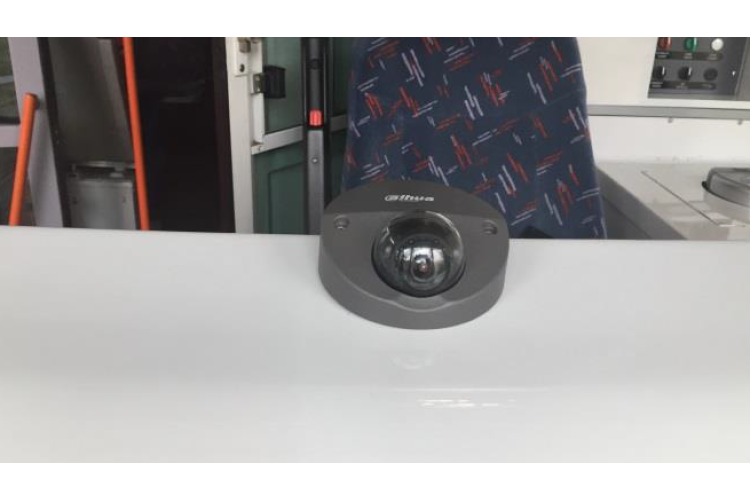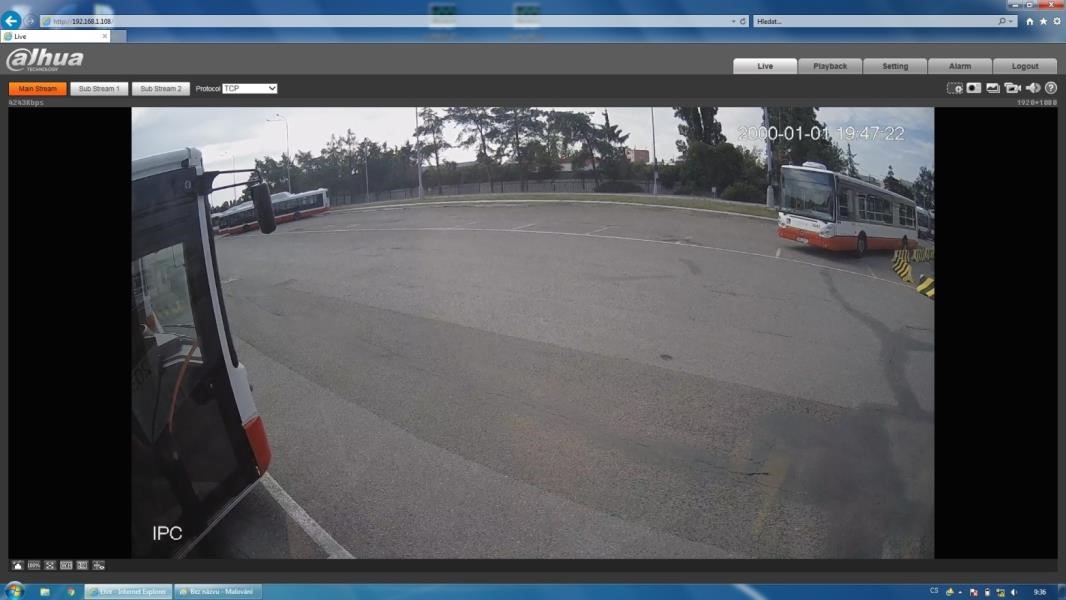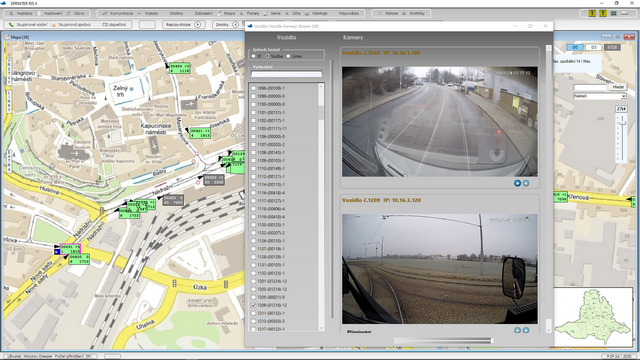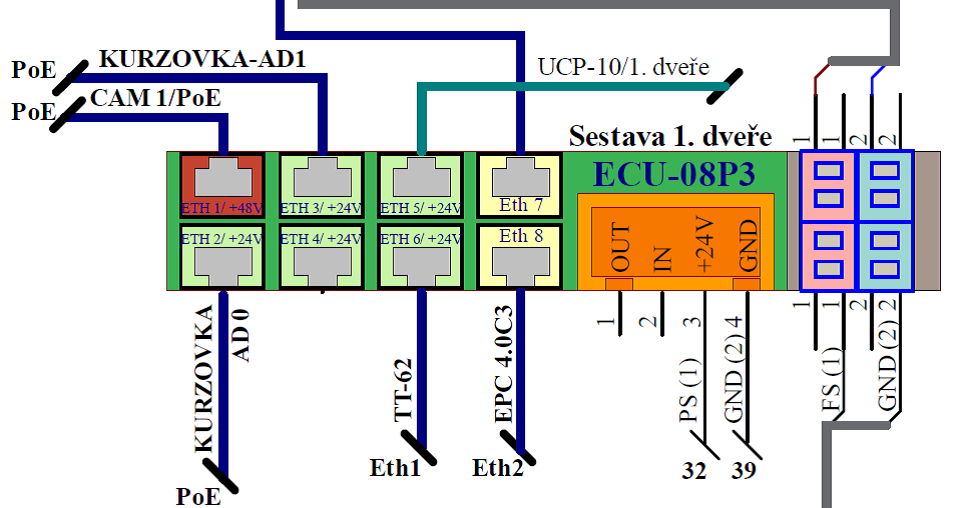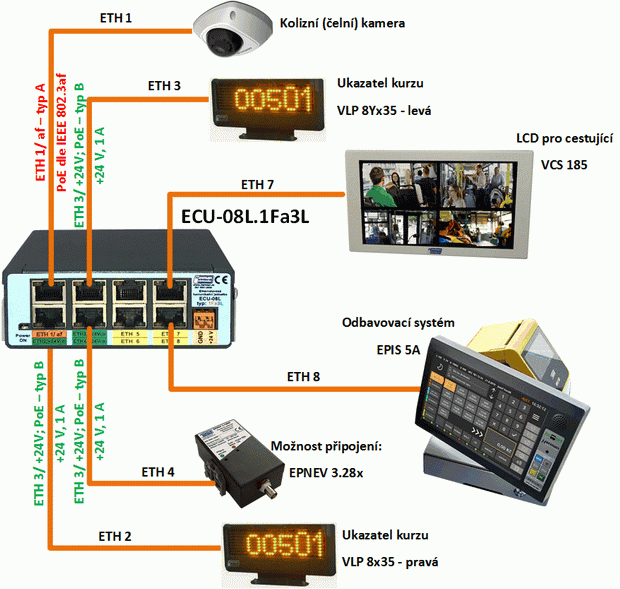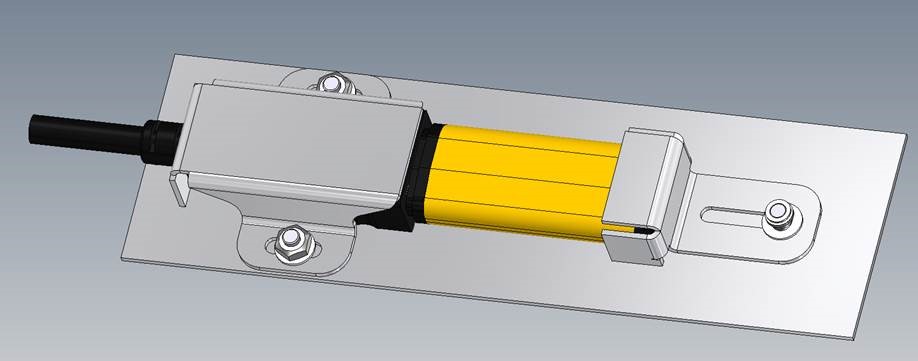Frontal security camera
The camera footage can be uploaded to the on-board computer on its SSD drive, sent to the control room or stored on an external USB drive and displayed on the driver's LCD terminal for the operator. It is thus a simple camera system that contains all the necessary functions of a camera system, but contains only 1 (or 2 cameras for bidirectional cameras).
Contact us
It is now possible to connect a front-facing security camera to the on-board computer EPIS 4.0Cx or EPIS 5.0A and thus create a simple camera system that includes one or two cameras (double-sided tram). Public transport vehicles are equipped with an internal static security camera for scanning the area in front of the vehicle. The camera is placed near the windscreen and captures the traffic in front of the vehicle - at least the right side of the road and the oncoming lane and records this on a USB disk or on the SSD of the control unit.
The camera recording can be uploaded to the on-board computer on its SSD drive, sent to the control room or stored on an external USB drive and displayed on the driver's LCD terminal for the operator. It is thus a simple camera system that contains all the necessary functions of a camera system, but contains only 1 (or 2 cameras for bidirectional cameras).
Operation of a front camera type camera system
The operation of a front camera system includes the following parts:
- The camera itself, located in front of/on the driver's dashboard or on the front panel of the vehicle (top view). It may by agreement have the IR illumination of the area in front of the camera switched off or on at night. If the illuminator is switched off, light from the vehicle headlights or public lighting is used for recording.
- Image processing controller - in this case it is an EPC 4.0Cx or EPC 5.0A controller, which processes the video signal for the external USB recording unit and for the internal SSD drive (the length of the recording depends on the size of the drive) in the form of either images or video.
- The external USB flash drive works on the same principle as the SD card, but with a different serial interface. This drive is placed in the operator's chosen compartment, giving the user the easy ability to remove it if necessary. Removal can be carried out in the event of a failure by an authorised person of the contracting authority. At the same time, the second backup medium may be the SSD of the control unit (in this case it cannot be removed).
- Separate driver display unit EPT - the camera system uses an external LCD monitor of the driver to display the current camera status. As this display is not relevant to the driver by default, it is used in service mode to check the function and to adjust the camera shots.
The camera recording can then be evaluated in the context of other operating parameters logged in the on-board computer - they have a uniform time stamp. The structure of the USB Flash drive is Linux EX4 and may or may not be encrypted as agreed.
Vehicle front camera footage played back in a browser.
Interaction with on-board computer
As mentioned, the EPIS 4.0Cx or EPIS 5.0Ax on-board computer serves as a control and recording unit for the frontal security camera image. The recording can be uploaded to the SSD either in the form of a video recording (stream) or in the form of images (e.g. 3 frames per second).
The EPIS on-board computers also include a service menu for working with USB recording. If the recording USB is removed in an accident, the recording must be cancelled and then the recording USB removed. A new USB Flash is then inserted and the recording is activated. The removed USB is then used to analyse the events in front of the vehicle.
If it is a double-sided tram, then the EPIS on-board computer determines which camera is going in the frontal direction (cab A or cab B) and activates the recording from the "frontal" camera accordingly.
Example of the service menu for checking the front cameras and possibly the independent vehicle camera system. The "disconnect USB" button changes according to the status of the recording USB flash drive.
Online display of the front camera on the control panel
Within the SPRINTER control dispatching software, it is possible to connect directly to the front safety camera in the vehicle and monitor the events in front of the vehicle on-line. This provides dispatchers with the possibility to be able to see the immediate situation in front of the vehicle in urgent cases, especially in the event of a traffic accident. The image from the camera is thus projected in a special window.
An example of the display of front camera images in a control room for the purpose of evaluating what is happening not only in the event of a crash, but especially for the purpose of checking the situation on lines and stops. The online display then saves the dispatcher a lot of control calls - just wait for a public transport vehicle to pass by. It is faster and cheaper.
Wiring in public transport vehicles
For easy wiring in vehicles to power the camera +48V - PoE type with negotiation (IEEE 802.3 af standard - type B), the Ethernet switch ECU 08P3 was developed. The front camera is thus plugged directly into the switch and does not need any additional element to provide power. Another advantage is that the on/off switching of the front camera is provided by the on-board computer according to the specified type of operation.
The principle of wiring the front camera in the vehicle using the ECU 08P3 .1F5P- includes a special with PoE output according to the IEEE 802.3 af standard and this with negotiation regarding the power connection.
Where it is sufficient to provide PoE power only for the front security camera and the other Ethernet bus wiring is already standard (without PoE), the ECU 08L.1F switch is designed (simple and inexpensive solution). It will provide +48V power to the camera - PoE type with negotiation (IEEE 802.3 af standard).
Both PoE outputs are capable of providing up to 9W of power at +48V.
Another option is to connect using the ECU 08L.1Fa3L switch, which already allows power supply for the 4-wire connection type - PoE type A:
Example of simplified wiring for IDS with front camera and heading indicators for this type of camera system.
Recording USB Flash Drive
Included is an industrial USB Flash drive with extended lifetime for storing data of a size corresponding to a recording duration of min. 4 hours in full resolution at a minimum of 20 frames per second. Its size is 8 GB with a rewrite capability of 64 TB, ensuring a lifetime of many years. If the recording is not downloaded from the on-board computer at the end of a shift, the recording is automatically overwritten.
The file system used is the Linux EX4 format, which allows automatic repair of corrupted files compared to FAT 32 from Windows, which is particularly advantageous in an industrial environment.
Mechanically, the recording USB Flash is installed in a compartment easily accessible to the dispatcher in the event of an accident. The recording USB plugs into the rear USB connector of the EPC on-board computer controller - called USB 2. When installing cables longer than 5 m, a USB cable with amplifier is used.
The recording USB Flash holder to which the recording from the front safety camera for the last 8 hours or more is recorded (depending on the capacity of the USB Flash).

